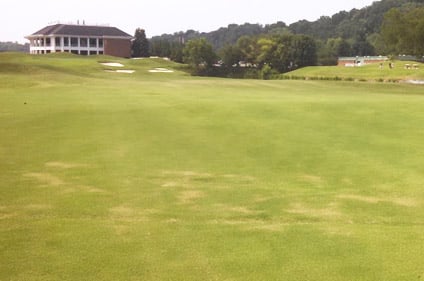Irrigation is used to supplement natural rainfall in order to maintain turf hydration, but that water suffers four fates:
- Water is lost to runoff.
- Water is lost to leaching.
- Water is lost to evaporation.
- Water is consumed by the plant.
Drought stress can happen on a daily basis. If weather conditions are right, a perfectly watered area can be dried by afternoon, leaving a plant in a stress situation.
Water is used by the plant for many more functions than simply hydration. Better than 90% of the water taken up by the plant is lost to transpiration. This water was previously used in conducting starches to the leaves. Transpiration also plays a critical role in the ability of the plant to cool itself.
Let’s face it: the plant cannot go look for shade. Lack of sufficient water for cooling purposes is also a large contributor to heat stress. Only about 1 to 3% of the water taken in is used in metabolic processes. But clearly, more water is needed to keep the plant functioning on an optimum level. Furthermore, environmental aspects including sun and wind play a very large part in loss and the demand for available rootzone moisture.
Water movement in the soil also occurs in different ways. Infiltration refers to water penetrating the soil surface. Percolation is the movement of water downward and laterally throughout the soil profile, and capillary action is the upward movement of water or a wicking type of effect.
Movement of water into the rootzone is the goal of irrigation, but there can be a number of situations that make this objective much more difficult. Soil structure is a strong influencer in terms of water penetration. Finer soils have smaller pore space reducing rates of water infiltration, and they can much more easily become compacted further reducing the ability to wet the rootzone. Terrain, crusted soils, excessive thatch, or broken-down soil structure due to sodic conditions also influence infiltration.
Another instance in the inability of water to move into the soil is due to the surface being water repellent or hydrophobic. This situation tends to be much more common on highly-maintained sites, such as a golf course or athletic field where the rootzone is a large percentage of sand.
In this case, soil particles become covered or partially covered with a waxy substance or by-product of living and decomposing plant material and microorganisms. This waxy coating will strongly repel water similar to that of a fresh coat of wax on the surface of your truck. This issue can occur on the surface or throughout the profile creating areas of preferential water flow resulting in non-hydrated areas or "localized dry spots (LDS)" which can be very troublesome even with routine irrigation. Performing a water drop test will determine if the soil is truly water repellent.
The LDS situation also becomes more prevalent when soils are not prevented from drying on a repeated basis. Historically, the number one tool for managing LDS has been a wetting agent along with hydration-aiding and drought-mitigating products.
Too often on new construction there will be spots or areas in the lawn that will dry out very quickly. The best tool in that case is a pitchfork or a soil probe. Look for buried construction materials and concrete which are typically the culprit, so it's handy to keep a soil probe nearby. Only by taking core samples and probing below the surface can you get a good idea as to what is really happening.
For drought tolerant species of turfgrasses along with watering requirements and other great information, visit the University of Massachusetts Amherst website.
Please contact the Ewing Technical Services Team with any questions.




